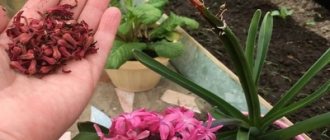Photo gallery
With the onset of winter, the plant begins a period of dormancy. At the beginning of this stage, you need to shorten the wood sorrel cuttings by 1 cm and put them in a dry, dark place. Watering and fertilizing stop completely.
Pruning and rejuvenation
In order for oxalis to look neat and not lose its decorative appearance, you need to cut off excess leaves, thinning them out.
You can buy both an adult plant and its bulbs both in nurseries and in regular flower shops. An adult plant from a nursery will cost 600–1000 rubles, depending on the diameter of the pot. Prices in stores may vary, but on average oxalis from a store will cost 200–600 rubles.
Bulbs from nurseries cost from 150 to 600 rubles. for a pack of 3 pieces, the final price depends on the variety.
The pot should be wide and low so that oxalis is more willing to grow daughter tubers.
To choose the optimal size of the pot, count how many bushes you plan to plant in it. Each shoot needs 5–8 cm of space. The material is not fundamental, but experienced gardeners prefer ceramic pots.
Caring for oxalis in open ground
Oxalis grows equally well in both partial shade and open areas. The soil selected is fertile, loose and breathable. The preferred soil acidity is neutral or slightly acidic. If there is a need, then before planting a flower, dig up the soil, and then add peat and compost. The seedlings are placed to a depth of 3-4 cm, the distance between them should be 10-12 cm. Planting is recommended in mid-April, in warm but cloudy weather.
Most often, natural precipitation is sufficient for oxalis, but if drought is observed, the bushes are watered in the morning or evening with a small amount of warm water.
Once every few months, the plant is fertilized with diluted minerals or Mullein.
In autumn, the flower needs to be prepared for wintering. To do this, mulch the soil near the rhizome. You don’t have to worry about the above-ground part of the oxalis, since it will dry out anyway, but the tubers will remain alive and healthy until next spring.
Soil for a flower
The soil for oxalis should be light, airy and fertile. It can be purchased at the store, however, if you want to be sure of the quality, you can make a suitable substrate yourself.
For oxalis, commercial soil for decorative foliage plants and universal soil for indoor plants with neutral acidity pH 6.4-7.3 are suitable. The advantage of buying a ready-made soil mixture is its availability and the reduction of the grower’s time costs. However, not everyone agrees to use ready-made soil, since one cannot be completely sure of its quality.
When purchasing soil for wood sorrel, pay attention to the following characteristics:
- best before date;
- compound;
- acidity.
After opening the package, make sure that there is no mold on the inside, and that the soil does not have an unpleasant odor or large hard lumps.
The soil for oxalis must contain potassium, otherwise, if there is a lack of it, the leaves will lose their bright color.
Lighting and temperature
Rose sorrel or lucky clover is a very heat-loving and light-loving plant. It should be placed in the south-eastern, eastern or southern parts of the house or garden.
Provided that the plant is located on the south side, the rose oxalis is shaded from direct sun to protect it from sunburn.
The temperature for the plant can be at +24 +27 °C. Higher temperatures deplete the openwork plant and can cause flowers and buds to fall off.
During the period of forced rest, the temperature for the plant is maintained at +12+14 °C.
How to prepare the land yourself?
To do this, mix peat, humus, turf, leaf soil and sand in equal parts to make the soil airy and slightly acidic.
An important stage in soil preparation is treating it against pests. You can do it like this:
- Place the soil in a colander and pour boiling water over it.
- Heat on a baking sheet in the oven at a temperature of about 85 °C.
This way you will destroy all harmful microorganisms and protect the flower.
A day after disinfection, the soil should be watered with a biological product to restore beneficial microflora.
The presence of drainage will prevent the roots from rotting and protect the plant from diseases. It’s easy to make – just fill 1/3 of the pot with expanded clay, shards, pebbles or broken bricks.
Edible species of sorrel
Oxalis tuberosa / Oxalis tuberosa
Oxalis tubers contain a lot of starch - up to 25%. The color of the tubers is white, yellow, pink, bright red and purple.
The tuberous sorrel is not found in the wild. And it is impossible to propagate it by seeds - the flowers are sterile. It is bred exclusively using tubers.
Read more about growing tuberous oxalis in our material>>>
Tubers of tuber oxalis.
How to transplant sorrel?
To prepare oxalis for transplanting, you need to stop watering for a while. As soon as the earthen lump dries, it will easily leave the pot.
The new pot should be 3–5 cm larger than the previous one, this will stimulate the formation of daughter flower tubers.
In the first 4 years of life, sorrel is transplanted once a year, then the periods between transplants increase to 2 years.
The transplantation process consists of the following stages:
- the plant is removed from the old pot;
- the roots are washed, and all rotten and broken shoots are removed and dried;
- a seedling is placed in moist soil in a new pot;
- the roots are covered with substrate and compacted a little;
- The transplanted flower is watered and placed in a bright place without direct sunlight.
Other reasons are:
- wrong soil;
- diseases.
Transplantation during flowering
It is preferable to replant oxalis immediately after emerging from dormancy, in the spring. But if you need emergency replanting and the oxalis bush is not yet devoid of leaves, proceed as follows:
- remove the plant, being careful not to damage the tubers.
- Place the whole lump in a new container.
- add soil without covering the stem.
The plant will calmly respond to an unscheduled transplant, the main thing is not to harm the roots.
Mistakes and ways to avoid them
In the process of growing oxalis, some gardeners make mistakes that negatively affect the condition of the plant.
The most common of them are eliminated in the following ways:
- Gradual drying of leaves and flowers - oxalis is exposed to direct sunlight. You can fix the problem by moving the pot to a slightly shaded place.
- Rotting of leaf plates and roots - excess moisture accumulates at the bottom of the container. In this case, it is necessary to adjust the watering regime.
- The plant is affected by pests. The cause of this problem is too wet soil. To normalize the situation, it is necessary to reduce the frequency of moisturizing.
- The interestingly colored leaves have degenerated into solid green. The flower lacks natural light, so it is necessary to move it to a sunnier place.
- The stem and leaves are too elongated. This happens as a result of over-fertilization. After identifying a problem, it is important to reconsider the feeding regime.
Oxalis is an ideal plant for growing indoors . The flower grows and develops well in temperate climates and does not require complex care. Proper planting and compliance with all growing recommendations will ensure its good condition for many years.
Reproduction
Oxalis reproduces well at home, and you can easily get new specimens.
Oxalis reproduces:
- Bulbs.
- By cuttings.
- Tubers.
- Leaves.
- Seeds.
It is almost impossible to grow indoor varieties of oxalis from seeds at home; it is better to choose other methods.
New plants can be obtained from tubers and bulbs, which, when replanting the mother bush, are easily separated from it. They are immediately placed in small containers with the prepared soil mixture and placed in a cool, dark place. The optimal temperature for planting during this period is about 15 °C.
After the sprouts appear, the pots are moved to light, the required temperature rises to 23 °C. In a month, the young plant will be fully formed. Propagation by cuttings and leaves is also not difficult.
After separating them from a large bush, they are placed in a container with water and wait for the roots to appear. As soon as the young roots reach one and a half cm in length, the shoots are planted in the ground.
It is better to propagate wood sorrel at the very beginning of spring, so that young seedlings have time to grow and become stronger by autumn.
Oxalis triangularis, or purple sorrel (Oxalis triangularis)
Common sorrel - description of the plant
Purple oxalis (in Latin Oxalis triangularis) is a herbaceous perennial belonging to the Oxalis family. A native of the southern regions of America and Africa, it was given the name butterfly flower in Russia. Oxalis is popular among summer residents due to its beneficial qualities.
Oxalis triangularis
The plant is responsible for purifying the air of toxins, healing and strengthening the body. The flower is placed indoors by those who want to heal faster and stay in good physical shape. Placing the plant in the office on the desktop or in the bedroom will help the owner correctly understand his calling.
Edible violet sorrel is suitable for consumption. It is used for treatment in alternative medicine.
The overseas newcomer has become a decoration of window sills since the last century. The plant impresses with its triangular leaves and intense purple color. In addition, strokes and spots of different colors can be easily distinguished on sheet plates.
Attention! This species has a green color, which amazes with its decorativeness and elegance. Small white flowers will delight you almost all year round.
Common Oxalis (Oxalis Acetosella)
The foliage of Oxalis acetosella is trilobed, some varieties have 4 halves.
The oxalis flower is characterized by a circular arrangement of petals on thin shoots, low above the soil, and a resemblance to the wings of butterflies. The stems are collected into a bush. The number of shoots gives it splendor. The home flower oxalis has a dark green or purple color. Plant height is limited to 30 cm.
Small flowers rise above the foliage. The popular varieties of wood sorrel have soft pink, snow-white or lilac buds.
Additional Information. Various beliefs are associated with the oxalis plant. It is believed that a flower for Christmas is the best gift for friends and family (it brings prosperity and success).
The peak of decorativeness of a perennial crop falls in spring and the arrival of the summer season.
Oxalis four-leaf
Four-leaved oxalis is considered a highly ornamental crop. In common people it is called the flower of happiness, false trefoil.
Flower growers grow Oxalis Depp Iron Cross as a potted crop.
A characteristic feature of Depp's sorrel is burgundy spots in the middle of the leaf blade, hence the name of the plant - iron cross.
Oxalis Depp Iron Cross
The original structure of the leaf blade resembles clover. Oxalis are used in landscape design. They are optimally suited for cultivation in unprotected soil as a ground cover crop in rocky gardens and carpet flower beds.
The perennial blooms for a long time. The inflorescences have a red-crimson tone. In Foggy Albion it is called lucky clover.
Oxalis carob
The herbaceous perennial crop reaches 40 cm in height. Thin creeping shoots release roots at the leaf nodes that are slightly pubescent upon contact with the soil. The compound leaves of Oxalis Corniculata include 3 heart-shaped segments. The length of the petioles is 1-7 cm.
Erect thin peduncles of Oxalis Rozhkova bear from 1 to 5 yellow-golden cup-shaped buds with 5 long petals at the top. The foliage color palette contains shades of greenish, burgundy, lilac, and brown.
Carob oxalis is not only a decoration, but also a weed in the garden
Carob sorrel reproduces aggressively, so its development is often restrained and fought like a weed.
Kislitsa Ortgis
The height of herbaceous sorrel with erect thick stems of burgundy color varies in the range of 15-30 cm. The leaves of Oxalis ortgiesii are complex, thin, long petioles include 3 leaf parts that resemble a fish tail in shape. The leaves are pubescent and glossy, with branched veins, the color is green-bluish or green. Leafless peduncles end in yellowish funnel-shaped flowers with 5 petals.
Fertilizer and feeding
During the growing season, from the end of winter to the beginning of September, oxalis needs feeding. They should be carried out once every 2 weeks. Both mineral mixtures and organic fertilizers are used:
- ammonium and potassium nitrate;
- urea;
- superphosphates;
- potassium salt.
The most popular brands are Fertika and Bona Forte.
Mineral ones are well suited for sorrel - nitrogen will help the plant form beautiful foliage, and phosphorus will strengthen the rhizome.
Oxalis requires a much lower concentration of fertilizers than is written in the instructions. The solution for oxalis should be made twice as weak.
Of the organic fertilizers, sorrel is guaranteed to like mullein solution, its leaves will become more luxuriant and flowers will appear. During the dormant period, any feeding is completely stopped.
You can also feed oxalis with homemade fertilizers. The most popular of them:
- wood ash;
- 1% yeast infusion;
- sugar;
- succinic acid;
- chopped banana peel.
How to care for sorrel at home?
Lovers of home flowers often have a pot of sorrel on the windowsill. The decorative appearance of the plant is influenced by compliance with the rules of care at home.
Oxalis at home should be placed closer to bright, diffused light. Although he doesn’t mind partial shading in the room, it will still have a negative effect on the decorativeness of the foliage.
Humidity
Reference. Oxalis is of tropical origin and likes normal to high humidity. In spring and summer, as well as in winter, when indoor air humidity is low due to heating, the plant should be sprayed. In the cold season, if the room is cool, spraying is not carried out so as not to overcool the plant.
Oxalis reacts well to droplets of water accumulated in the leaves . However, wet leaves should be protected from direct sunlight to prevent burning.
The hotter the room, the more often oxalis is sprayed. Use boiled water at room temperature.
Air temperature
In summer, Oxalis is suitable for room temperature from +20 to +25 °C. With good watering and high humidity, the plant can withstand up to +27 °C. Species that shed their leaves for the winter need to be provided with a period of rest.
Starting from October, the temperature is gradually reduced, bringing it to + 10-12 °C in winter. If possible, the pot should be placed in a slightly heated room. In such conditions, oxalis is kept for about 1.5 months, after which, by spring, the temperature is raised again.
Important! If the temperature is not reduced in the autumn-winter period, then flowering may not occur in the next season.
For those species that do not shed leaves, a winter temperature of +15 to +18 °C is suitable.
Feeding
Indoor oxalis needs feeding during the period of active growing and flowering, from April to August. Complex mineral fertilizers are used. The complex is suitable for decorative deciduous plants.
If nitrogen predominates in the composition, it will affect the active growth of foliage. In this case, a thick, lush bush will form. For good bright flowering you need phosphorus and potassium.
Oxalis requires half the dose indicated in the instructions, so the solution is made 2 times weaker. The resulting solution is watered at the root of the flower. The procedure is carried out once every 2-3 weeks. To avoid burning the roots, moisten the soil before fertilizing. Make sure that the fertilizer does not get on the leaves and flowers. In the fall, feeding is stopped, giving the plant rest.
Watering
In spring and summer, oxalis needs constant watering, every 1-2 days. A hard lump should not be allowed to form; only the surface of the soil should dry out. But it is not recommended to overfill, since stagnation of moisture in the pot can lead to rotting of the root system. After each watering, remove water from the pan.
For irrigation, use settled soft water. In extreme cases, boiled water will do. But you can’t regularly water it with boiled water.
Important! During the dormant period, watering is reduced to a minimum, avoiding overdrying. Varieties that shed their leaves are not watered in winter.
Lighting
Oxalis requires a lot of light, but does not tolerate direct sunlight. Under the scorching sun, the plant will fold its tender leaves and then droop.
It is best to place the pot on a west or east window. On a north window, with a lack of light, oxalis will bloom only with additional artificial lighting. Some varieties are taken out onto the balcony for landscaping in the summer. Outdoors in the warm season, oxalis develops and blooms well.
The soil
For oxalis, loose, light soil with neutral or weak acidity is suitable. The chemical composition must include potassium. Infertile soil will lead to fading of leaves and loss of decorativeness.
You can buy a ready-made mixture in the store, or you can make it yourself. For soil you will need in equal parts:
- turf land;
- leaf soil;
- coarse river sand;
- peat;
- humus.
Important! A drainage layer of broken brick or expanded clay pebbles is placed at the bottom of the pot.
To avoid infecting the plant with pests, the soil mixture is heated or frozen before use. You can also water it with a solution of manganese, and put charcoal particles in the drainage layer.
Trimming and shaping
Oxalis does not require special formation of the bush. In summer, you should only remove dried flowers and leaves in a timely manner, as they spoil the decorative appearance, being plant debris. If you let the peduncles and stems dry completely, they can easily be torn off by hand.
The time for complete pruning depends on the conditions in which the oxalis will be in winter. If you can keep it at a temperature of +13-14 °C, then all shoots are cut off in the fall, just before the dormant period. If the sorrel remains at a higher temperature, then pruning of the foliage is carried out in the spring.
When the dormant period ends, the dried peduncles and leaves of the oxalis are cut off. The shoots are shortened by several centimeters. This will stimulate the development of new growth, the setting of a large number of buds and lush flowering.
Transfer
Oxalis grows quickly. It is recommended to replant young plants every year, older ones - once every 2-4 years.
To plant oxalis, it is better to choose a wide pot so that several bulbs can fit in it. In this case, you will get a luxurious lush bush. Boarding order:
- A drainage consisting of expanded clay or broken brick is placed at the bottom of the pot.
- Pre-prepared soil is poured on top.
- The plant is removed from the old pot with a lump of earth.
- Carefully clean the roots from the soil, rinsing them with running water.
- All rotten roots are removed, after which the rhizome is dried a little.
- The bush is placed in a pot, the voids are filled with soil and lightly pressed down.
- Water and place in diffused light.
If sorrel is bought in a store or brought into the house from another place, it is quarantined for 2 weeks, isolating it from other indoor flowers.
Problems during cultivation
As a rule, flowering does not occur for two reasons:
- The plant does not go into a dormant period; over time it becomes very depleted.
- Excess fertilizer - in this case, oxalis forms a lush head of greenery to the detriment of flowering.
Diseases
Oxalis can be subject to rhizome rotting. This disease is caused by excessive watering and stagnation of water in the pot.
The solution to the problem is to dig up the oxalis, remove the soil, cut off the affected areas of the root and replant it in fresh, slightly dried soil. Moderate watering can be used to prevent re-development of the disease during the recovery period.
Pests
Pests that attack oxalis under unsuitable conditions:
- spider mite White cobwebs appear. To remove them, the plant must be washed with soapy water;
- scale insect. Brown insect shell tubercles appear on the leaves. Flower treatment is carried out in the form of mechanical removal with a soft brush and soap. If necessary, spray the plant with chemicals (“Aktellik”, “Fitoverm”, “Metafos”);
- aphid. Small insects that leave behind a sticky coating appear on leaves and stems. For treatment, they are removed mechanically and the plant is treated with insecticides (Neoron, Iskra, Kinmiks).
Problems with leaves
- With long-term growth of sorrel in the shade, its leaves become smaller and lose color.
- Sometimes leaves dry out due to insufficient moisture or excessive lighting.
- exposure to direct sunlight causes burns
Thus, to create optimal growth conditions, oxalis should be placed in a place with diffuse but bright light and monitor soil moisture.
Errors when leaving
Common mistakes in caring for indoor oxalis:
- Choosing the wrong pot.
- Using heavy soil.
- Lack or excess of light.
- Excessive or insufficient watering.
The picturesque and undemanding nature of oxalis has won the hearts of many. Leaves reminiscent of a flock of butterflies will decorate any windowsill, and the abundance of varieties will delight even the most demanding gardeners.
Botanical description
Pink sorrel (lat. Oxalis rosea) belongs to the sorrel (lat. Oxalidaceae) and is a perennial, herbaceous, low plant.
Flowering begins in February and can continue until the end of summer.
Simple four-petalled small pink flowers are collected in groups of 3-4 pieces on a long peduncle that droops over time.
This feature gives the flowers a cascading arrangement.
The peculiarity of the flowers is that they bloom in very sunny times, and in the evening they always close.
On very long petioles, delicate trifoliate leaves of an intense green color are attached They, like the flower stalks, droop over time, which gives the rose oxalis an element of an ampelous appearance.
For this plant, it is necessary to force a period of winter rest. , rose oxalis for a period of one month until young shoots form. After this, the flower is returned to its usual conditions.











